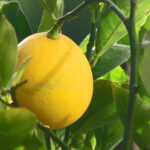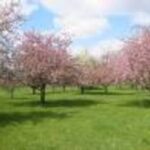A few years ago, my kids begged for an apple tree in the back yard. After perusing the garden catalog from Stark Brothers nursery, I chose Goldrush for its disease resistance.
Five years later, my dwarf Goldrush apple tree is large enough to produce about a bushel of fruit in October. I also get attractive blossoms in the spring. Because Goldrush apple trees are bred to be highly disease resistant, I have gotten my yields without spraying. Many of the apples are not as picture-perfect as those from the grocery store. I use the ugly apples to make and freeze applesauce, following Mark Bittman’s recipe in How to Cook Everything. I save the best apples for fresh eating and storage.
Those thinking about growing Goldrush apple should be aware that the best yields require pollination from another variety of apple tree, and that the choice of the second apple variety is important. So if you want to grow Goldrush, it’s helpful to have room for a second tree. If space is tight, try to find a neighbor who wants to grow apples. I use a semi-dwarf Jonafree apple, which is also disease resistant, to pollinate my Goldrush apple tree.
My Goldrush apples are smaller, crisper, and more acidic than many supermarket apples. They have a sweet-tart flavor. When picked, the fruits are greenish yellow wiht pink-tinged spots. They become more truly yellow when stored. The Goldrush apples will keep for several months with refrigeration or in a cool space, such as a garage or unheated cellar.
A cooperative breeding program of the Illinois, Indiana, and New Jersey Agricultural Experiment Stations developed the Goldrush apple. Illinois designated the Goldrush apple its offical state fruit in 2008. They are a cross between Golden Delicious and an experimental apple variety.





